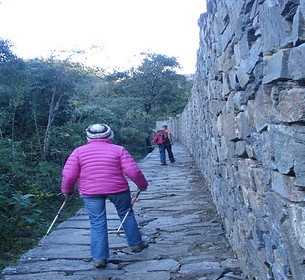Services in Marampata Campsite in Cusco
- Camping – yes, 5 soles / tent
- Hotel – no
- Store – yes
- Cooked food: yes
- Hygienic services with running water: yes
- Toilet – yes
- Shower – yes
Food in Marampata in Cusco
Here are several small kiosks you can buy. They also have eggs, vegetables, soups, pasta, cookies, French fries, chocolate, and some canned goods.
Marampata in the route to Choquequirao is located at kilometer 28 of the Choquequirao tour 4 days / 3 nights and at 2,850 meters above sea level, from here you have a beautiful view of the archaeological complex of Choquequirao Peru.
The Marampata campsite in Choquequirao route is a small town with several campsites, stores to buy food and even a small hotel. It is the best place to rent a mule if you are too tired to continue the trek on your own.
Marampata in Cusco is a camp, this is an additional 1-2 hour climb from Santa Rosa, and very picturesque. There are decent camping and hot food options here, and Choquequirao is on the horizon.
Marampata in the Choquequirao route is a small town with a couple of houses that sell food.

marapata 
marapata
Choquequirao trek
From Cusco, you will need to take a combination or a taxi to the city of Cachora. You’ll want to take a taxi from Cachora to Capuliyoc, a viewpoint where the road ends and the trail begins. This will shave about 13 kilometers from your hike so you have more time and energy to overcome the steep slopes and gradients that characterize this route. The trail may seem deceptively short on a map, but the constant switchbacks and steep ups and downs make it a much longer and more strenuous hike than initially perceived.
There are two possible midway campsites: First, Playa Rosalina, the official campground. Alternatively, if you’d rather have the longest part of your trip off the trail on the first day, keep trucking to Santa Rosa. The next day, you will finish the trip to the ruins, where you will spend the second night.
When you finally get to Choquequirao, the ruins easily rival those of the famous Machu Picchu, without all the crowds of tourists. In fact, it’s not uncommon for travelers to have the entire site to themselves. The remains cover 18 square kilometers. On the ridges above the main part of the city, the old houses of the nobility and the rich overlook warehouses, temples and houses of the common people.
After spending one night in Choquequirao, you will return the same way you came. The walk back is as difficult as entering, but when you return to Capuliyoc, you can relax, enjoy a beer and feel proud of your achievement. Far fewer people have visited this incredible site than Machu Picchu, so you will become a member of an exclusive and very adventurous club.
Route options
The Choquequirao trek to Machu Picchu has a series of routes and itinerary variations. The walks can last between 5 or 10 days. The itinerary detailed below is for a 9-day trek from Choquequirao to Machu Picchu.
Note: There are also several options for standard trekking to Choquequirao, with additions of ground transportation to Machu Picchu. We briefly expose them in the section: Choquequirao Alternative Treks below.
Best time for the Choquequirao trek
The best time to do a Choquequirao trek to Machu Picchu is between May and September. Unlike the Inca Trail, which is bustling during this time, the road through Choquequirao is quiet and not crowded. Prepare for the crowds at Machu Picchu, as this time of year is the peak tourist season.
The months before the dry season, April and October / November, can also be a good time to walk.
The rainy months of December, January, and February are not great for hiking.
Acclimatization and altitude sickness:
The Choquequirao trek to Machu Picchu is one of the toughest alternative routes on the Inca Trail 4 days / 3 nights, reaching a maximum altitude of 4,668 meters in the Yanama Pass.
It is important to spend a day or two in Cusco acclimating before starting your Choquequirao trek. Staying well hydrated and taking the walk at a steady pace is key to preventing the onset of acute mountain sickness (AMS).










